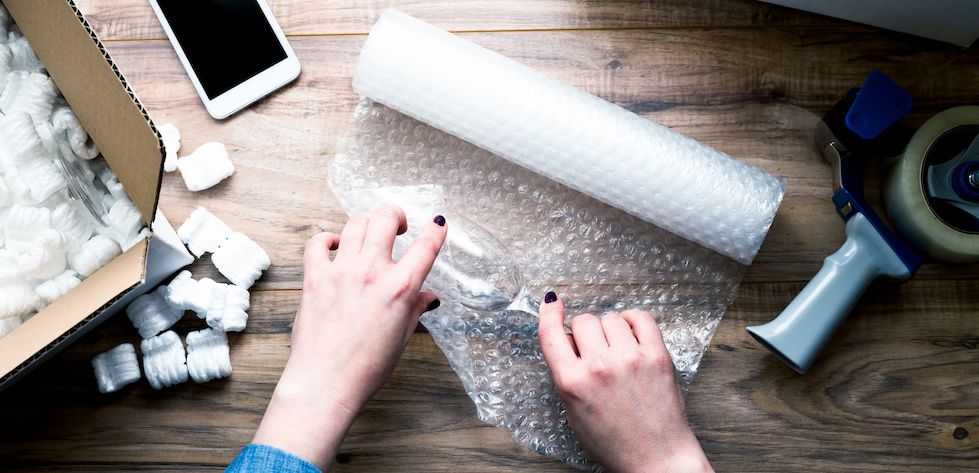The Ultimate Guide on How to Pack Fragile Items for Moving.

Imagine the scene: It’s moving day, and you’ve just arrived at your new business premises. You unpack your first box and discover the antique vase that used to sit on your CEO’s desk has smashed into a hundred pieces. It was an office heirloom — your CEO’s most valuable “valuable.” As the person who arranged your corporate move, you’ve got some explaining to do…
Or after moving into your new home, you open your set of precious crystal glasses from your grandmother only to find them destroyed. And only because you didn’t make time to properly learn how to pack glasses for moving. Don’t let this situation happen to you. So, make it a point to learn how to pack fragile items for moving. Here are some helpful tips for packing expensive, fragile items for your long distance move.
1. Create a Fragile Items List.
Creating a list of your most fragile valuables will help you identify the items that need a little care and attention. Note down items that are at risk of damage during transportation. Note down items that are at risk of damage during transportation.
These fragile items you will be moving commonly include the following things:
- Drinking glasses
- Plates
- Artwork
- Lampshades
You can add picture frames to this list, as well. Before you find out how to pack pictures for moving, add these items to your list.
2. Don’t Overpack Boxes With Fragile Items.
Overloading boxes and containers with glass items and other fragile valuables is a big no-no. The result? Damaged valuables that could cost thousands of dollars to replace. Not sure how to pack your belongings properly? Call in the experts. Nelson Westerberg specializes in packing and unpacking services for your long distance corporate move. This service proves you with multiple benefits. Most people don’t know how to pack picture frames for shipping, for example.
3. Use the Right Packing Materials To Pack Your Fragile Items.
Whether it’s a plastic wrap or packing tape, using the right packing materials will avoid a moving day disaster. Oh, and don’t forget to label boxes with delicate items so everyone is aware of the contents. Write “Fragile!” on the top, bottom, and sides of each box.
4. How to Pack a Fragile Item – Secure the Box with Cushioning and Lining
Once the supplies are ready, start by lining the bottom of the box with a layer of cushioning material, such as crumpled packing paper or bubble wrap.
Next, wrap each fragile item individually with bubble wrap or packing paper. Make sure to cover all sides of the object and secure it with tape. For particularly delicate items, it may be necessary to double-wrap them for added protection. It is also advisable to place a layer of cushioning material between each item when placing them in the box to prevent any potential contact and reduce the risk of damage. Fill any empty spaces in the box with additional cushioning material to ensure that the items remain stable during transit.
Talking about boxes, follow these tips, too:
- Place super-fragile items like drinking glasses and plates at the top of moving boxes.
- Place items like paintings at the bottom of boxes (but don’t place too much weight on top of these items).
5. Seal Boxes Securely & Reinforce
When closing the box, make sure to seal all openings securely with packing tape. It is recommended to reinforce the bottom of the box with an extra layer of tape for added strength. Clearly label the box as “fragile” on all sides to alert handlers to handle it with care. This will help ensure that the box is treated appropriately throughout its journey. Finally, keep a record of all fragile items packed and their corresponding boxes for easy identification and unpacking.
In conclusion, packing fragile items requires careful attention and proper techniques. By following these steps and using the right materials, it is possible to protect delicate items from damage during transportation. Taking these precautions will give you peace of mind knowing that your fragile items are well-protected and will arrive safely at their destination.
Want to know how to pack breakables for a long distance move? Reduce moving day stress by following the three steps above. Creating a list of fragile items, packing boxes properly, and using the right packing materials will reduce breakages and irreversible damage.
Related Articles
Moving Out Soon? Your Guide to Start Saving Today

Moving out is a thrilling milestone that brings both excitement and financial challenges. Proper preparation and strategic saving are crucial for a smooth transition to independent living, requiring more than just accumulating a lump sum. Beginning this process requires a thorough approach, from evaluating your current financial circumstances to preparing for lasting stability. By implementing […]
Read MoreFirst Time Moving Out? Your Essential Checklist & Guide

Stepping out on your own for the first time is a thrilling adventure that marks the beginning of true independence. It’s a journey filled with excitement, but it also comes with its fair share of challenges that require thoughtful preparation and planning. Moving from your family home to your own space involves more than just […]
Read More




